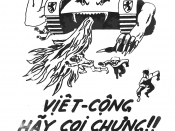Outline
I. Background
A. Introduction
B. Vietnam -- two separate countries
1. French Control
2. Viet Minh Revolt
3. Creation of North and South Vietnam
C. America's objectives in South Vietnam
D. Vietnam's armies
II. Vietnamization
A. Beginnings of Vietnamization
B. Research of possible withdrawal
C. Decision to withdraw
1. began in early 1969
III. American Withdrawal and South Vietnamese Buildup
A. Short history
B. Advisor and troop reductions
C. Combat assistance team reductions
D. South Vietnamese buildup
E. South Vietnamese military additions in 1972
IV. The Fall of Vietnam
A. Easter Offensive
B. Ceasefire
1. Goes in to effect on January 28, 1973
C. Break of the cease fire and North Vietnamese offensive of December,
1973
D. Final offensive in 1975
E. Resignation of President Thieu
F. General Minh assumes the Presidency
G. Minh fails in negotiations
H. Minh gives in to all North Vietnamese demands
V. Conclusions
Background
Vietnam was a country that was far removed from the American people until their history and ours became forever interlinked in what has come to be known as the Vietnam conflict. It is a classic story of good guys versus bad, communism versus freedom, and a constant struggle for stability. Americas attempt to aid the cause of freedom was a valid one, but one that ended up with South Vietnam being dependent upon us for its very life as a nation. 'Vietnamization' was the name for the plan to allow South Vietnam to stand on its own, and ended in leaving a country totally on its own, unable to stand and fight.
Vietnam was a French territory until the Viet Minh insurgency of the late 1940's and through 1954. Although regarding this uprising as part of a larger Communist conspiracy, Americans were not unsympathetic to Vietnamese aspirations for national...


